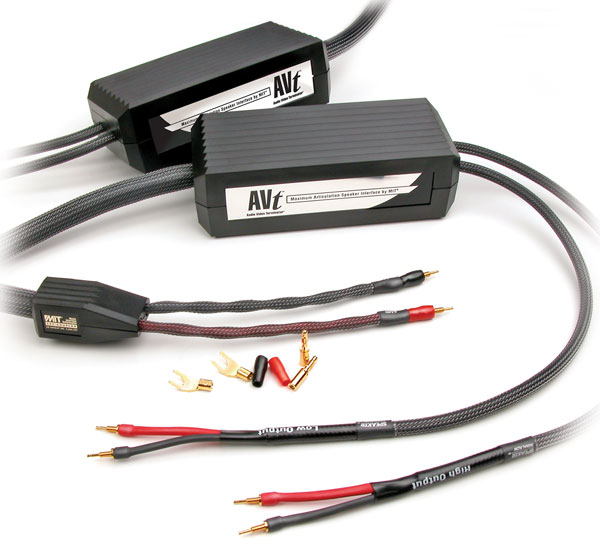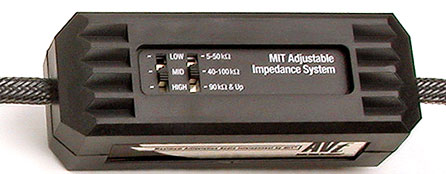Cables have to be the most underappreciated component. I chose the word “component” carefully, since I fully intend to convey that cables are a component in today’s high-end audio. Proof of this is found in the exquisite lengths (pun indented) cable manufacturers are going to producing conduits which will convey all the proper information. A case in point is Music Interface Technologies, or MIT, and their series of cables utilizing arrays of built-in passive electronics.
This is the kind of thing that sparks wars between audiophiles; electronic devices in cables? Heresy! Sacrilege! Interesting! Indeed, these are very interesting devices since on many levels they are superior to many traditional cables sans electronics. How can that be? Let’s find out!
Bruce Brisson, the founder of MIT, started out designing cables in the 1970’s and after licensing several of his designs to Monster Cable, he went on to found MIT in 1984. The low-pass filter network employed in MIT cables was created in 1989, and the Terminator was born. The purpose of the Terminator was to “control the efficiency of the network throughout the entire audio range, allowing the entire music signal to pass throughout the system with minimal distortion.” Bruce certainly knows something about cable design, since he’s worked with some notable names including Spectral, Jeff Roland, Wilson and Marin Logan.
The build quality of the cables is first rate, with the main run of cable ensconced in a silvery-grey mesh outer jacket over the thick dialectic. The positive and negative leads are colored red and blue for easy identification, the amplifier leads being approximately 9” long, and 18” on the speaker end. One of my favorite amplification setups is a pair of bridged Pathos Classic One MkII stereo tube hybrid integrated’s, which utilize only the outermost-positioned posts in that mode. The MIT cables reached adequately but were stiff and must be worked with to position. To install them in a system where the amp or receiver is in a cabinet, or where access is limited could be challenging. However, my intuition is that most persons involved with MIT’s would likely be utilizing dedicated, two-channel rigs and power amps which would require open access.
Regarding burn-in, MIT warns the owner to avoid any kind of active burn-in device, since it may harm the passive component array in the boxes. Their adage regarding burn-in time is the “2/2 Rule”, meaning that one can expect 75% of performance in two days of burn-in and 100% in two weeks. The owner is advised not to utilize any active burn-in device on the patented “Multipole” cables as it may harm the electronics.
The MIT’s certainly look much more like components than traditional cabling. They have unmistakable rectangular boxes on the speaker end with bold print declaring their name. These are not little, flexible cables, but hefty and quite stiff. Possibly the greatest issue I had with the cables was that they were challenging to move and connect to components. Intentional or not, there was a solution to the dilemma, and it came from an unlikely source: the “iCon” connectors included with the cables.
MIT has cleverly devised their own system of interchangeable terminations, called “iCons”, threaded posts which are fitted with any combination of bananas, spades or pins. This assures accommodation for virtually any component. The transition from spade to banana etc. is quick and effective. All iCons are gold plated. Though the iCons are removable, the cables are considered pre-terminated. The beauty of the iCon system came into play since the speaker and amp leads were so stiff that they had to be worked into position.
When connecting cable, one may have to snake it through certain AV furniture, or around a corner, and the optimum position for the terminator box may not be possible. In such circumstances, it may be quite difficult to twist the lead of the positive or negative cable to accommodate the terminal of the amp or speaker. In such cases, one can do the unthinkable and simply loosen the spade slightly to rotate it to fit. Yes, I know that doesn’t make for the ultimate connection (and that a soldered connection is superior, i.e. spades with physically fixed connections), but in the real world most people aren’t going to rearrange their furniture to accommodate a speaker cable, especially when among that particular furniture there happens to be their components which need to be located precisely! The ability to turn a spade just a hair is tremendously helpful when trying to accommodate the inflexibility of the cable.
One should not be put off by the minor issues due to cable stiffness, since these MIT’s are quite the exceptional performers. Once a cable is in place, stiffness or flexibility means nothing – sound means everything. Indeed, it seems MIT has designed their cables physically to convey sound properly, and they excel at this. The modules look very authoritative, like the system is declaring the message, “We’re not screwing around with audio here – even the cables have electronics!”
People that are out to impress others would love these just because they look big and bad. But, of course, no audiophile worth his salt should be in it simply to impress others; it’s all about the music. I feel it’s best to acknowledge the reality of ego in audio purchases, not that it drives purchases but certainly contributes to them. I admit it, I love the imposingly big look of these cables.
Skeptics of MIT’s designs may conclude that customers are being sold a wire with an empty box, or a “psychoacoustic” advantage. MIT strives to put that thinking to rest with their literature printed and posted for all to see; MIT is working to perfect the science behind cable structure. They claim not to be just slapping terminations on raw wire, but are testing, charting, working with the electronics to improve their designs.
The most notable instance of this is the “Multipole Network Technology” (the box), which, according to MIT, contains multiple passive components, “…wired in parallel,” passively correcting the shortcomings of traditional cable designs. The idea is that a cable without the “Multipole” technology can articulate ideally only in a limited range of audible frequencies. The “Multipole” technology adds additional poles, or regions of maximum articulation, to extend the maximum articulation of the cables, hence the “MA” designation.
Whatever those electronics inside the boxes are doing, the MIT cabling faithfully transmitted the detail, depth, and three-dimensionality of the sound. Prior to becoming a Dagogo reviewer, I conducted A/B comparisons with several well-known cables and settled on the MIT’s, specifically the Shotgun S3’s. Part of my motives for reviewing the AVt MA’s was to see how much of a difference in sound the higher end Multipole cables made. In a nutshell, they made a respectable difference, so much so that after having the Shotgun S3’s in my system for the better part of a year, I could not return to them after switching to the AVt MA’s. The level of finesse and clarity was distinct to the degree that I could easily hear the improvement.
And why wouldn’t I hear the difference, since there are more of those passive electronic devices in the MA cables? MIT has a clever thing going by displaying the number of the Multipole technology for each cable. Want good results? Look for a cable with “8X Multipole” technology. Better yet, find one with “16x” and you’re improving. The MA interconnects I received have 16X Multipole power and the speaker cables have 26X – now we’re rockin’! The top of the line MA Oracle speaker cables have 71X and the Oracle IC’s have 68X.
Speaking of the IC’s, these are the real attraction in the system with their additional “selectable impedance” switch. Beyond having the Multipole technology, these incorporate a function to allow switching the impedance going into the destination component. There are often vastly differing input impedances between preamps, amps and integrated’s and the source. “Switchability” in the interconnect allows for optimizing impedance of the signal entering the destination component. The thinking is that much of the mixing and matching of components between brands and impedances is a hindrance to achieving the best sound. Selectable impedance minimizes these differences.
Does it work? Yes, and remarkably so! The three settings for impedance on the single-ended IC’s I used (there are two sets of switches on the balanced IC’s) range from LOW (5-50KΩ), MID (40-100kΩ) and HIGH (90kΩ and up). I found that the cables performed consistently as advertised. No matter which pre/amp/integrated I used them on, the ultimate performance took place when the interconnect was set to the destination component’s input impedance. I was able to change the setting “on the fly” while listening without any obstruction to the music. While changing the settings at the equipment rack, it sounded so subtle that I wondered if the change was “worth it”, but when I sat back down in my listening chair, it was obvious a worthwhile change had been effected. If the “wrong” impedance was set, the sound became muddied (that’s a harsh word to use, and does not at all suggest the speaker cables were producing poor sound. It is simply to clarify the imperative that the IC’s be set on the proper setting for premium performance). When the setting was correct, the entire event was focused sonically, similar to bringing into focus the field of vision with a camera lens. Since I was working with only one set of the MA interconnects, for the most dramatic improvement I kept them on the source, a Rega Saturn. If the utilization of a second MA interconnect would impact the system as well as this, these ICs alone would become a formidable component.
- (Page 1 of 2)
- Next page →



